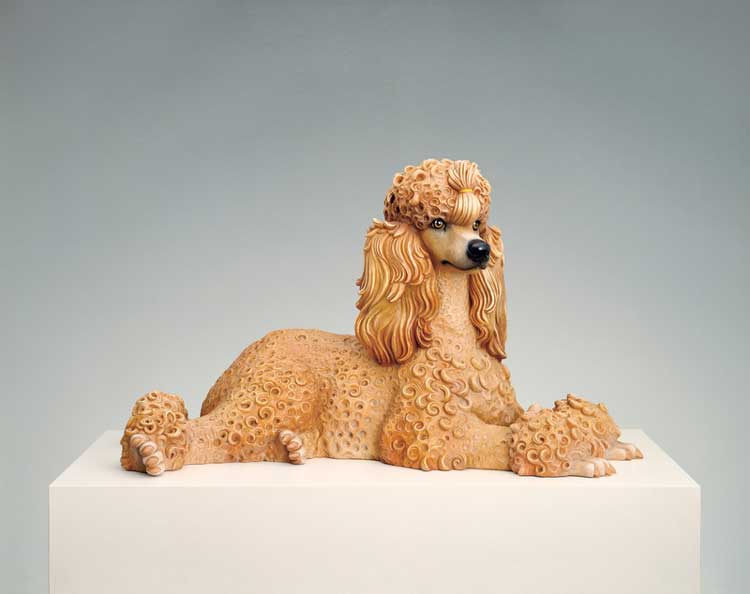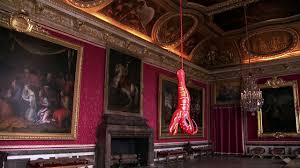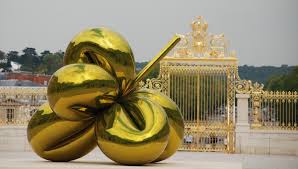One thing that came across in Jeff Koons’ recent Broad-sponsored (“Un-Private”) conversation with John Waters was a sense of the satisfaction Koons took from his work as a bond salesman and commodities trader on Wall Street. His fascination with commercial exchange began early, while still a boy, selling items door to door. He has been fascinated with selling – and what sells – ever since. Critics tend to place undue emphasis on his appropriation of kitsch as subject and substance of his art, sidestepping the more fundamental aspect of the work which is the sell itself: the implicit promise of a chimerical trust, even ‘transcendence’ – something seemingly tangible yet intangible, entirely fungible yet unique to each purchaser.
That was part of the genius of the inflatables. What could be more basic (if not actually base), more ‘pure’ as an expression of unfettered, impulsive desire, than the glimmer of some shiny toy or novelty or sentimental souvenir that captured the strolling consumer’s (or better still – a child’s) eye and held it for a critical split second? What could be more expressive of the pure sell – a shiny package of nothing more than hot air? Or, again going back to that world of door-to-door salesmen, the inversion – the vacuum cleaners (objects sucking the air and the chimeric dust right back) and floor polishers to keep it all shiny; the purity of the transaction, the transcendence, all preserved within Plexiglas.
To see those inflatables suspended in the King’s and Queen’s apartments at the Château de Versailles, the floor polishers installed in their plexi-vitrines in the Galerie des Glaces, was itself a moment of historic redemption – even transcendence – richly earned, that could scarcely be surpassed. Yet here we are with the (I suppose) inevitable retrospective. It seems almost anti-climactic. Even here there’s an implied note of lèse-majesté: not just the final show, but the biggest ever undertaken by the Whitney at its iconic (albeit soon-to-be-vacated) Breuer home, and which is practically being taken apart to accommodate it. (How much further, by comparison, did MoMA have to go for its 1980 Picasso retrospective? The scale begs comparison with 20th century icons – Picasso, Duchamp; and – as it’s occurred to all of us more than a few times – Koons learned a thing or two from Warhol about the fame machine.)
What’s astonishing is the extent to which the mainstream media buys into it ravenously, feeding the frenzy, the bubble of sheer ambition, without a shred of close (much less cross-) examination. It’s as if all that counts is the ambition, the scale, the exhausting detail, the logistics – as complex and exacting as a strategic military maneuver. We saw this in The New York Times last Sunday with Carol Vogel’s feature spread across the front page of the Arts and Leisure section – the photos documenting surfaces and textures of Koons’ latest monument to Play-Doh in luscious detail. Sure, go ahead – “Sell Big” – but did anyone think to ask him why? (Ditto Koons’ remark about the “Play-Doh” textural detail, “It’s like a Rodin sculpture.”) As usual, Koons managed to be uncannily self-revealing: “It’s a moral exercise to make something as realistic as possible.” Vogel offered no follow-up. Nor did Vogel or anyone else think to ask Koons whether he considered it a moral exercise to make something as monumental as possible.
It was interesting how this statement resonated with Koons’ commentary on his sales/trading career in his conversation with John Waters. “Sales is the front line of morality.” It might be to someone who subscribed to a somewhat literal-minded reading of Max Weber’s thesis on the the ‘Protestant Ethic’ and commercialism (the ‘Spirit of Capitalism’). Whether the realism or verisimilitude related directly to the ‘sell’ or some notion of saleabiity (or for that matter, straight ‘work ethic’), there’s a certain perversity at play in Koons’ peculiar ‘gloss’ on this aspect of the social contract. What’s being sold, after all, is essentially hot air.
Nor was there much questioning of Koons’ own problematic relationship with his commercial partners and buyers (the collector who purchased “Play-Doh” will actually take possession only after its exhibition at the Whitney – more than 20 years after it was commissioned; he has reportedly pushed dealers, fabricators and collectors to the brink of bankruptcy). It hardly needs to be pointed out that the Koons retrospective, which has already cost the Whitney millions according to associate director and curator, Scott Rothkopf, will be the most expensive exhibition ever mounted by the museum.
There’s almost an element of self-reproach in the New York/international art world reflected in the Times coverage. “By all accounts an artist with this much celebrity should have had at least one major show in a New York museum by now.” Well yeah, I guess – but why does it feel almost redundant? It’s not as if the work’s going to get any smaller. I’ve often wondered why Koons never tried to replicate the Montgolfier brothers’ original hot air balloon, or some re-imagined toy version of it (although Murakami has already done a slightly scaled-down version of something like this).
Koons is always going on about ‘reassurance’ and ‘removal of anxiety’ in his bland Methodist-minister-monotone. But why must the ‘removal of anxiety’ coincide with a ‘removal of judgment’? It’s anyone’s guess whether Koons is styling himself as the Dr. Phil of the art world, or perhaps its Temple Grandin – leading his collectors to the slaughter. And where does the drive toward monumentality figure into it? To the extent it might, he’s already given us Puppy (perhaps my favorite Koons, right alongside the 3-basketball 50/50 (Levitation) Tank). Beyond that, the on-going Celebrations, Hulk-Elvis’s and Popeye’s are sheer grandiosity, and on a scale the Sun King himself could have scarcely imagined (much less stomached). It could be called a bubble, or even a fascist aesthetic. In the meantime, the Whitney goes on whipping up the drama, and even the Times is caught pumping up the bubble. Koons “sells big” and the Times sells it ‘bigger.’ And when the bubble bursts? Koons will go right on selling.





















that is the silliest thing I’ve read in quite awhile.
Comparing Koons to Dr. Phil and Temple Grandin is genius. Pure Genius! If Koons could only be more evil than Dr. Phil and more nonplussed than Temple Grandin, he might have created something that people actually cared about.